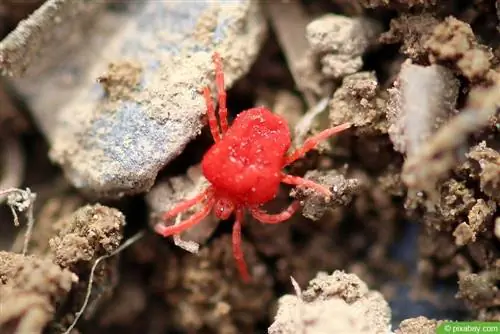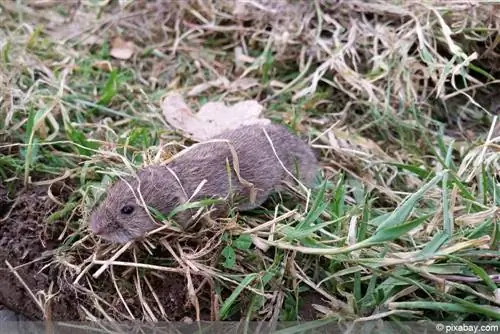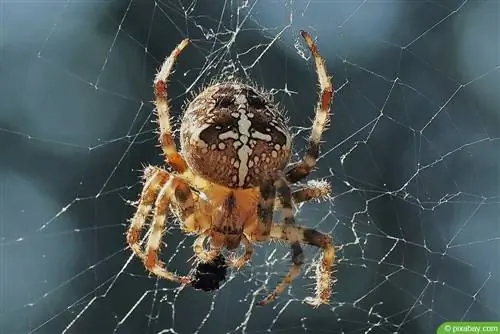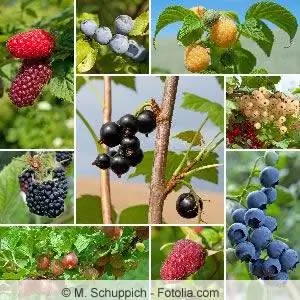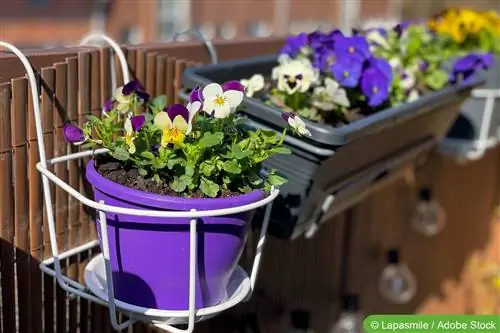- Author admin [email protected].
- Public 2023-12-17 03:39.
- Last modified 2025-01-24 12:45.
A pest rarely comes alone. The little red spider appears in droves, which makes its presence even more unhygienic. No matter whether in the garden or on the balcony, many people are wondering how to get rid of spiders. Since the velvet mite appears primarily close to the house, it is in the user's interest to use a gentle, biological agent. But what measures are possible? Here those affected will find the most effective methods to eliminate the little red spider.
Close up
The arachnids are mainly active in summer when temperatures are warm. When the thermometer drops, they retreat into the ground. A warm apartment as a retreat is also welcome. If the animals manage to get into the house via the balcony, they do not fall into their usual hibernation period, but rather stay alert throughout the winter. Their active metabolism demands food, so the velvet mite feeds on houseplants. To prevent them from entering the apartment, the gardener should seal all cracks with silicone. Fly screens in front of the windows are of little use in this case as they are too large for the tiny animals.
Note:
The spider mites do excellent decomposition work and are therefore actually considered beneficial insects. If they occur in a place in the garden where the gardener does not find them a nuisance, he should leave the population alone.
Humidity changes significantly
Experience has shown that spider mites tolerate both high and low humidity. However, a sudden change bothers them. It is best for the gardener to place plants that can tolerate direct sunlight and drought in full sun so that the substrate dries out. Regularly spraying the plant washes away the annoying animals and also ensures more humidity. However, not every plant can tolerate a strong shower of water.
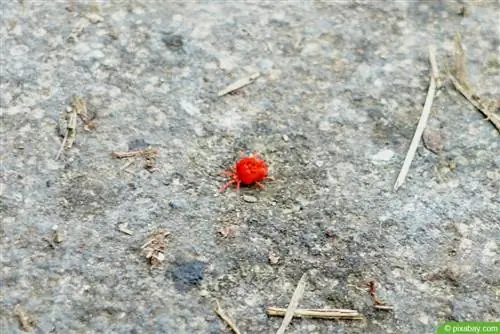
A great alternative is to place the plants on a saucer. Many affected people do not consider this option because they fear that the plant could be damaged due to waterlogging. But if the gardener fills small pebbles into the saucer, the irrigation water evaporates and increases the humidity. Bark mulch has the same effect on plants outdoors.
For very small infestations in the garden
In the initial stage, the gardener prevents further spread by removing affected plant parts and disposing of them well packaged in organic waste (not in the compost!).
Note:
Regularly checking balcony or terrace plants helps to detect an infestation early and prevent the spider mite from spreading explosively.
Oxygen deprivation
Like any other living creature, the spider mite needs air to breathe. The gardener takes these from her in the following way:
- Put a clear plastic bag over the planter
- only remove after 8 to 10 days
- Continue care measures such as watering and fertilizing as usual during this time
- pay attention to mold formation
- Repeat the measure after a short break until all the animals have disappeared
Potash soap solutions
Gardeners can also fight red spiders by spraying their plants with a potassium soap solution. He makes them like this:
- 1 liter of water
- with 15 ml liquid potassium soap
- and mix 15 ml of spirit
- spray on the plants every 4 to 5 days
Note:
This application must definitely be real Kali soap. Conventional dishwashing liquid is no substitute.
Alternatively, you can make a homemade plant decoction made from field horsetail or nettle leaves as well as rapeseed or neem oil.
Attracting beneficial insects to the garden
- Ladybug
- lacewings
- Predatory mites

the velvet mite likes to eat. They also protect the plants from other pests such as aphids. A small insect hotel in which the beneficial insects find shelter fits even on the smallest balcony. Predatory mites are commercially available. The most recommended is the genus Typhlodromus pyri. She feels most comfortable at a humidity of 70% and a temperature of 24°C. It is therefore recommended to use it outdoors in summer. The previous application of the potash soap solution described above increases the chances of successfully fighting the spiders with the predatory mite.
Redesigning the garden
Prevention is still the best control measure. Both as a preventative measure and after an infestation has been successfully eliminated, the gardener should structure his or her garden in a pest-friendly manner. Monocultures in particular attract vermin. In a good neighborhood, however, the plants protect each other from diseases. With the right care, the gardener also contributes to the he alth of his plants. Thanks to a sufficient supply of nutrients and the appropriate choice of location, they develop their own defenses to defy the velvet mite.
Note:
If an infestation cannot be eliminated using the measures mentioned, the gardener should not resort to chemical agents indiscriminately. In this case, it is better to contact a specialist who can estimate how much poison is acceptable from an ecological point of view.

